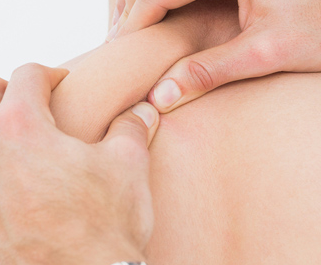The dorsal scapular nerve is a nerve that arises from the cervical spinal nerves C5 and C6. It supplies the rhomboid muscles, which are responsible for retracting the scapula and elevating it. The nerve also innervates the levator scapulae muscle, which elevates the scapula and tilts the neck laterally.
The dorsal scapular nerve emerges from the posterior triangle of the neck and runs deep to the trapezius muscle. It is a motor nerve and does not have any sensory function. Damage to the dorsal scapular nerve can result in weakness or paralysis of the rhomboid and levator scapulae muscles, leading to shoulder and neck pain, limited shoulder movement, and shoulder blade winging.
Medical conditions that can cause dorsal scapular nerve damage include cervical spine injuries, cervical disc herniation, cervical spondylosis, and surgical injury. Treatment for dorsal scapular nerve injury typically involves physical therapy and exercises to improve muscle strength and range of motion. In severe cases, surgery may be necessary to repair nerve damage.

Dorsal scapular nerve Pain
The dorsal scapular nerve is a nerve that originates from the cervical spine and innervates the muscles that control the movement of the scapula, or shoulder blade. If this nerve becomes compressed or irritated, it can cause pain, weakness, and discomfort in the upper back, shoulder, and arm.
Common causes of dorsal scapular nerve pain include poor posture, repetitive strain injuries, trauma or injury to the neck or upper back, and cervical disc herniation. In some cases, nerve entrapment syndromes such as thoracic outlet syndrome or cervical rib syndrome may also be to blame.
Treatment for dorsal scapular nerve pain typically involves a combination of physical therapy, massage, and anti-inflammatory medication. In some cases, nerve blocks or surgical intervention may be necessary to relieve persistent pain or discomfort. If you are experiencing dorsal scapular nerve pain, it is important to consult with a healthcare professional to determine the underlying cause and develop an appropriate treatment plan.
Dorsal scapular nerve Injury
Dorsal scapular nerve injury occurs when there is damage or trauma to the dorsal scapular nerve, which controls the movement of the scapula or shoulder blade. The nerve originates from the cervical spine and travels through the upper back, where it innervates the rhomboid muscles and levator scapulae muscles.
Common causes of dorsal scapular nerve injury include direct trauma to the nerve, repetitive strain injuries, cervical spine surgery, or a neck injury such as whiplash. Symptoms of dorsal scapular nerve injury typically include pain, weakness, and decreased range of motion in the affected shoulder and upper back.
Dorsal scapular nerve Entrapment
Dorsal scapular nerve entrapment occurs when the dorsal scapular nerve becomes compressed or pinched along its course, leading to pain and dysfunction in the upper back and shoulder. The entrapment can occur at various locations, including at the level of the neck, where the nerve exits the cervical spine, or in the region of the rhomboid muscles, which the dorsal scapular nerve innervates.
Common causes of dorsal scapular nerve entrapment include poor posture, repetitive strain injuries, cervical disc herniation, or spinal stenosis. In some cases, underlying structural abnormalities such as a cervical rib or scoliosis can also contribute to nerve entrapment.
Symptoms of dorsal scapular nerve entrapment typically include pain, weakness, and decreased range of motion in the affected shoulder and upper back. Treatment options may include physical therapy, massage, and anti-inflammatory medication to alleviate pain and improve muscle function. In severe cases, nerve blocks or surgical intervention may be necessary to release the nerve from its entrapment.
Dorsal scapular nerve Innervation
The dorsal scapular nerve is a nerve that arises from the brachial plexus, specifically from the ventral rami of the C5 nerve root. It runs along the medial border of the scapula, and it innervates the rhomboid minor, rhomboid major, and the levator scapulae muscles.
The rhomboid minor muscle is responsible for retracting and elevating the scapula, while the rhomboid major muscle acts to retract and rotate the scapula. The levator scapulae muscle is responsible for elevating and rotating the scapula.
In addition to these muscles, the dorsal scapular nerve also sends branches to the trapezius muscle, which is responsible for elevating, retracting, and rotating the scapula. The dorsal scapular nerve also provides sensory innervation to the skin overlying the medial border of the scapula.
